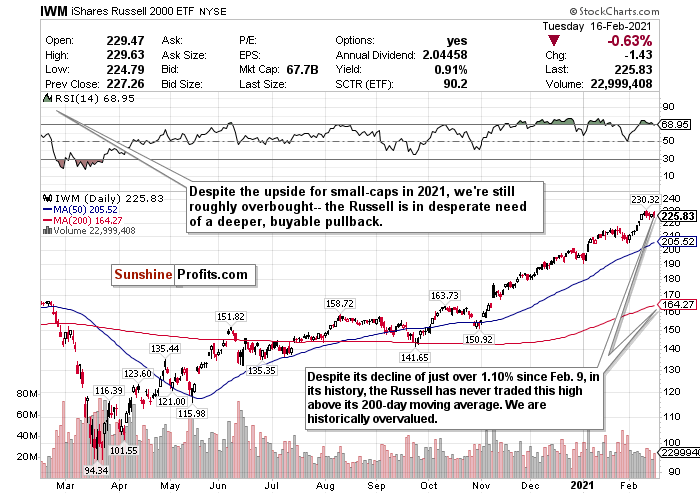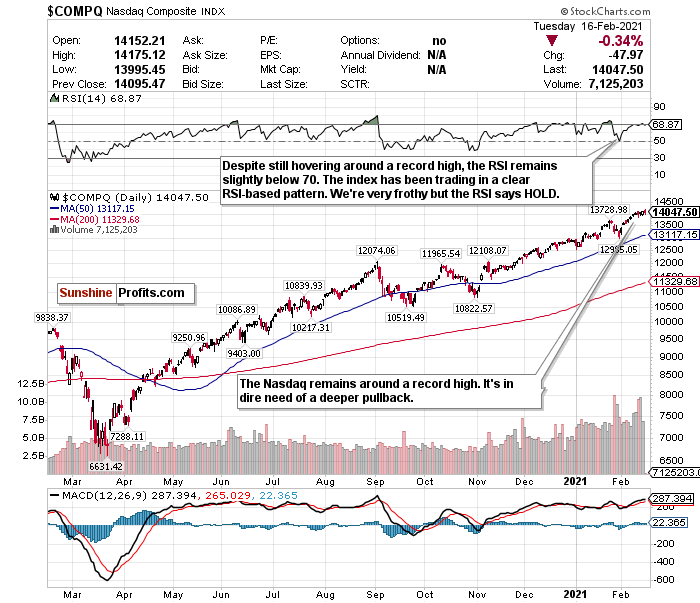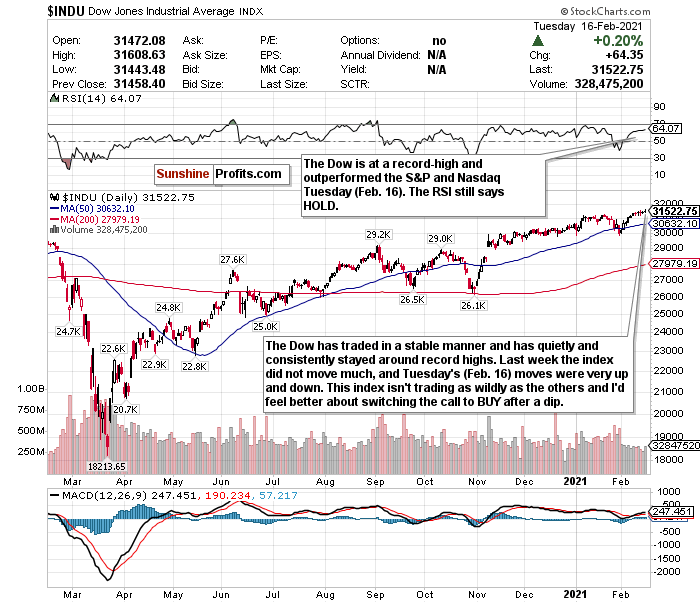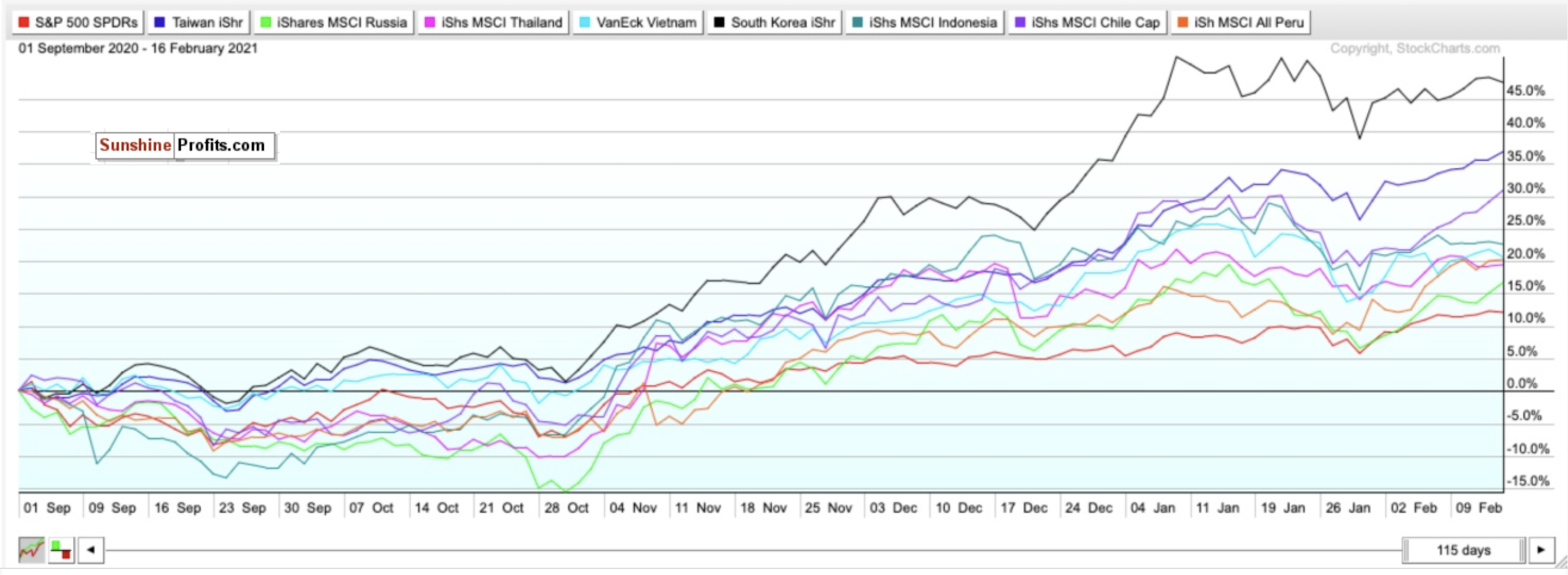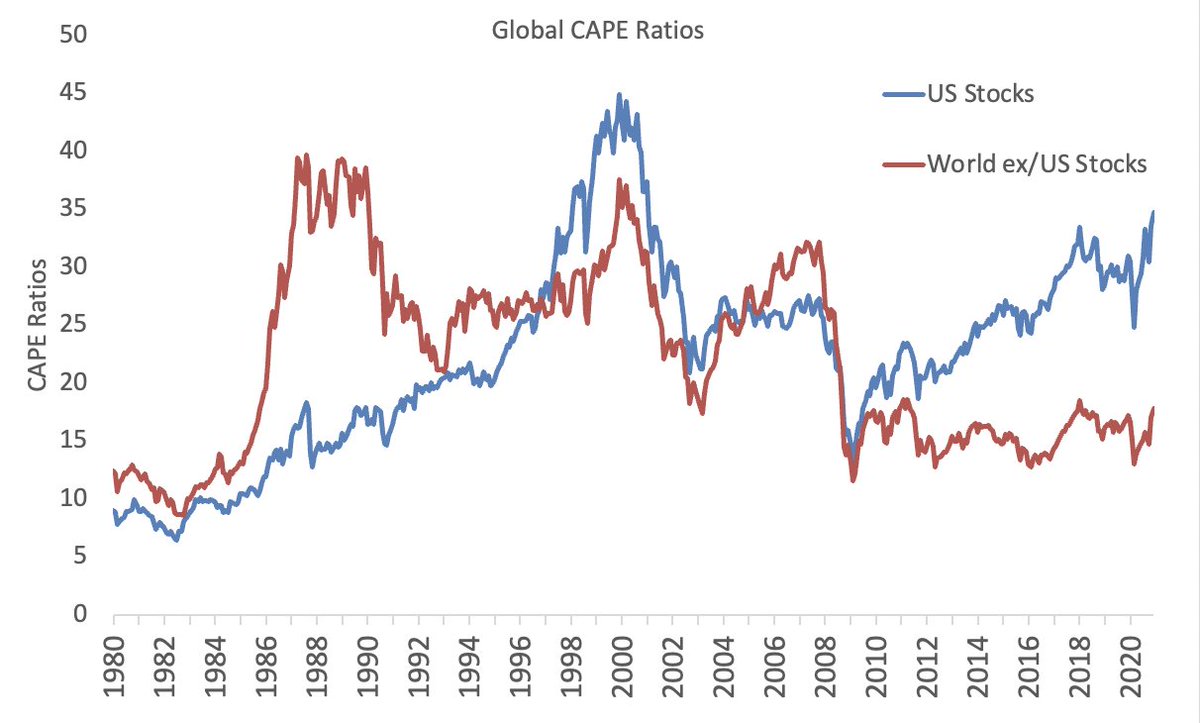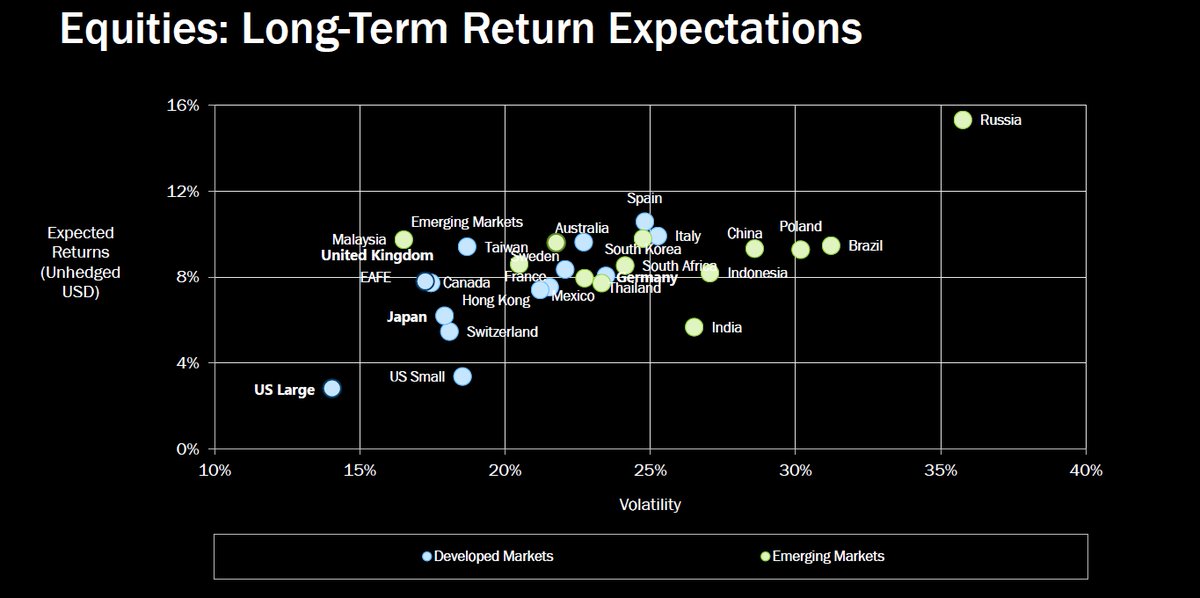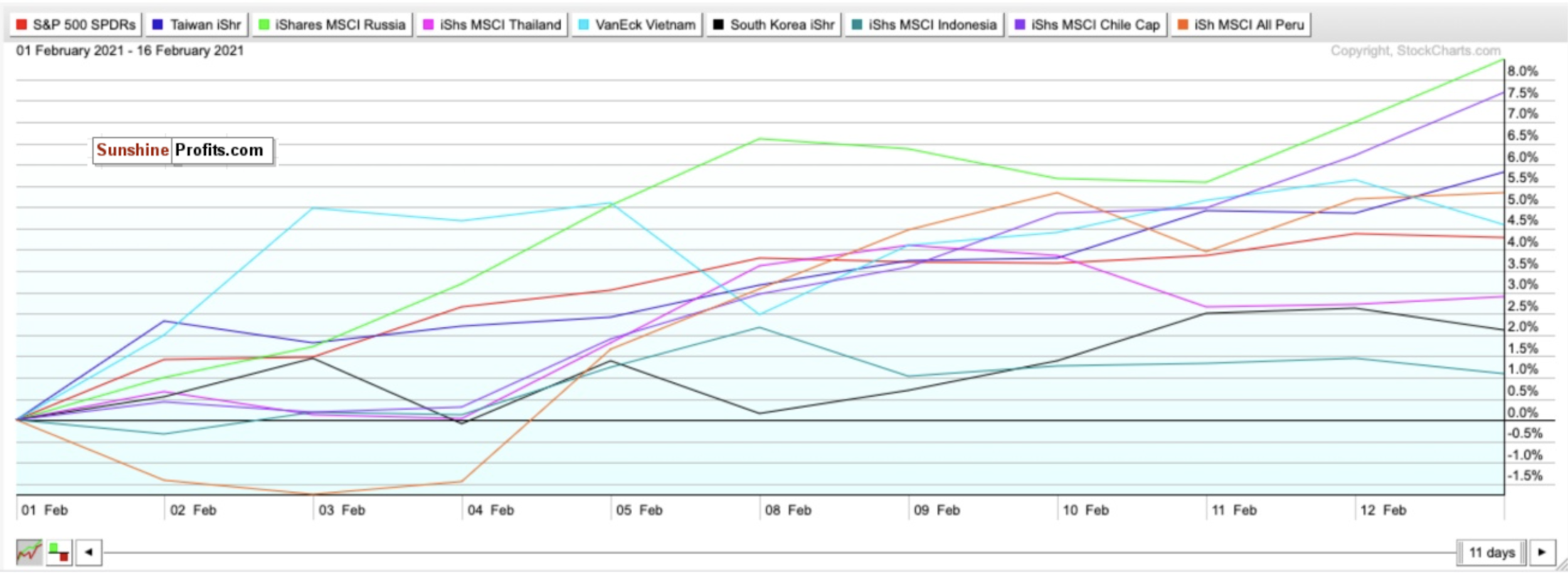The market largely continued last week’s mixed moves, with the S&P and Nasdaq mildly retreating from record highs and the Dow eking out another record close.
The sentiment remains mostly rosy thanks to earnings that continue to impress, plummeting virus numbers worldwide, indicators that the economic recovery is gaining steam, and imminent stimulus.
But we’re not out of the woods yet, and I still worry about complacency and valuations.
But now, you can add one more concern to the list- rising bond yields.
On Tuesday (Feb. 16), the 10-year Treasury yield jumped 9 basis points to top 1.30% for the first time since February 2020. The 30-year rate also hit its highest level in a year.
Why is this concerning?
Rising interest rates=less attractive stocks.
Sure, the banks benefit. But what do you think this means for growth sectors such as tech that have benefited from low-rates?
You couple that with the fact that according to the Buffet Indicator (Total US stock market valuation/GDP), the market could be 228% overvalued, and tech stocks may be at valuations not seen since the dotcom bubble? Genuine concerns.
A rebound in rates could also put a dent in the economic recovery if both companies and consumers find it increasingly expensive to borrow.
While I don’t foresee a crash like we saw last March and feel that the wheels are in motion for a healthy 2021, I still maintain that some correction before the end of Q1 could happen.
Bank of America also echoed this statement and said last week that “We expect a buyable 5-10% Q1 correction as the big ‘unknowns’ coincide with exuberant positioning, record equity supply, and ‘as good as it gets’ earnings revisions.”
Corrections are healthy and normal market behavior, and we are long overdue for one. They are also way more common than most realize. Only twice in the last 38 years have we had years WITHOUT a correction (1995 and 2017).
A correction could also be an excellent buying opportunity for what could be a great second half of the year.
My goal for these updates is to educate you, give you ideas, and help you manage money like I did when I was pressing the buy and sell buttons for $600+ million in assets. I left that career to pursue one to help people who needed help instead of the ultra-high net worth.
With that said, to sum it up:
While there is long-term optimism, there are short-term concerns. A short-term correction between now and the end of Q1 2021 is possible. I don’t think that a decline above ~20%, leading to a bear market, will happen.
Hopefully, you find my insights enlightening. I welcome your thoughts and questions and wish you the best of luck.
Small-Caps-No Longer Overbought but Still Frothy
Figure 1- iShares Russell 2000 ETF (IWM)
The Russell 2000 small-cap index has been lagging since last week after overheating.
However, it’s overdue for a larger pullback.
As tracked by the iShares Russell 2000 ETF (IWM), small-cap stocks have been on a rampage since November.
Since the market’s close on October 30, the IWM has gained nearly 48% and more than doubled ETFs’ returns tracking the larger indices. If you thought that the Nasdaq was red hot and frothy, you have no idea about the Russell 2000.
Since the market’s close on January 29, the Russell has done just about the same again. The IWM gained 9.86% and outperformed all the other major indices by a minimum of 3% in that period.
Not to mention, year-to-date, it’s already up a staggering 16.71%.
The IWM’s 1.12% decline since February 9 is hardly a sufficient enough pullback from the level it’s been at and the level it’s currently sitting at.
It needs a larger pullback. Desperately. Although the RSI is thankfully below the 75 it had early last week, it’s still roughly overbought.
It pains me not to recommend you to BUY or HOLD the Russell because I love this index’s outlook for 2021. Aggressive stimulus, friendly policies, and a reopening world could bode well for small-caps.
But the returns in the short-run need to cool off for a better entry point.
SELL and take profits. If and when there is a deeper pullback, BUY for the long-term recovery.
Tech Remains Frothy
Figure 2- Nasdaq Composite Index $COMP
Tech is frothy, and valuations are absurd.
However, somehow, the Nasdaq is not technically overbought. The Nasdaq fractionally retreated from its record close on Tuesday (Feb. 16), and declined to about 1.13 RSI points away from being overbought.
If tech is so obviously frothy and overvalued, why am I taking the RSI so literally?
Because the Nasdaq is trading in a precise pattern.
I remain bullish on tech and the earnings that continue to crush estimates. I'm also incredibly bullish on subsectors such as cloud computing, e-commerce, and fintech for 2021.
But please monitor the RSI.
Since December, let's break down the Nasdaq and how it has reacted whenever the RSI has exceeded 70.
December 9- exceeded an RSI of 70 and briefly pulled back.
January 4- exceeded a 70 RSI just before the new year and declined 1.47%.
January 11- declined by 1.45% after exceeding a 70 RSI.
Week of January 25- exceeded an RSI of over 73 before the week and declined 4.13% for the week.
It also declined about 0.25% after exceeding a 70 RSI earlier last week.
Every single time the RSI exceeded 70, I switched my Nasdaq call to a SELL.
The RSI is right at about 70, but technically it’s below it. I'm bullish but still concerned about valuations.
In case you forgot, consider this too. Goldman’s non-profitable tech index is at about an absurd 250% year-over-year performance.
Because of the Nasdaq’s precise trading pattern, I will follow the RSI literally and keep this a HOLD. If you took profits earlier last week when the RSI was above 70, good on you.
For an ETF that attempts to directly correlate with the performance of the NASDAQ, the Invesco QQQ ETF (QQQ) is a good option.
Dow’s Time to Shine?
Figure 3- Dow Jones Industrial Average $INDU
This could finally be the Dow Jones’s time to shine. After underperforming the S&P 500, Nasdaq, and Russell 2000 both year-to-date and month-to-date, the Dow seems to have some momentum on its side.
On Tuesday (Feb. 16), it was the only index to rise (albeit fractionally) and close at a record. It’s also the only index that hasn’t traded as if it’s on MDMA and may have the most room to run.
There are still underlying concerns, and the market is more of a house of cards than anyone realizes. However, the Dow is comparatively stable and undervalued and possibly more attractive as a potential BUY opportunity.
If you want to start initiating positions, go ahead. It’s at a decent entry point, especially considering that many analysts call for it to end the year at 35,000.
From my end, though, the RSI is quietly ticking up, and I still have some short-term questions and concerns.
I feel like the Dow could see another pullback.
My call on the Dow stays a HOLD, but this could change soon.
For an ETF that looks to directly correlate with the Dow’s performance, the SPDR Dow Jones ETF (DIA) is a reliable option.
Beware of Inflation
“The rich world has come to take low inflation for granted. Perhaps it shouldn’t.” -The Economist.
Complacency, an overvalued market, and rising bond yields are my biggest short-term concerns.
But my biggest mid to long-term concern has to be inflation. Pay very close attention to the possible return of inflation by mid-Q2 or Q3.
The President of the Federal Reserve Bank of Kansas City, Esther George, kicked off February by telling Bloomberg News that the Fed was still “far away” from achieving its goals and that it was too soon to discuss scaling back its unprecedented massive bond-buying program.
Fed Chair Jay Powell echoed this in his statement last week. The Fed will clearly allow the GDP to heat up and possibly overshoot in the medium-term.
We will see what happens to GDP growth by the end of Q1 2021, but I no longer think it will sputter as much as I previously thought.
If at all.
Rising bond yields also show that investors expect inflation to eventually return and are bracing for the GDP to heat up. Richmond Federal President Thomas Barkin described this as a “reflation trade,” or a sign that investors are preparing for future hikes in prices and demanding higher interest rates.
If you are looking to the future to hedge against inflation, look into TIPS, commodities, gold, and potentially some REITs.
In the mid-term, I have BUY calls on the SPDR TIPS ETF (SPIP), the Invesco Optimum Yield Diversified Commodity Strategy No K-1 ETF (PDBC), and the iShares Cohen & Steers REIT ETF (ICF).
Mid-Term/Long-Term
Surging Commodities= Add Emerging Market Exposure
Figure 4- SPY, EWT, ERUS, THD, VNM, EWY, EIDO, ECH, EPU comparison chart- Sep. 1, 2020-Present
Since September, the SPDR S&P 500 ETF (SPY) has gained around 12.18%. When you compare that yield to that of my top emerging market picks for 2021, it has underperformed.
When you look at the CAPE ratio of U.S. markets compared to the rest of the world, this also seems like an awfully low bang for your buck.
The CAPE ratio takes real earnings per share (EPS) over ten years and smooths out fluctuations in corporate profits that can always occur throughout different business cycles. It’s also known as the Shiller P/E ratio.
Consider this too.
A surge in commodity prices due to a weakening dollar combined with shifting demographics could send emerging markets upwards in the long-term too.
PWC also believes that emerging markets (E7) could grow around twice as fast as advanced economies (G7) on average in the coming decades.
For 2021, the following are my BUYs for emerging markets and why:
iShares MSCI Taiwan ETF (EWT)- Developing country, with stable fundamentals, diverse and modern hi-tech economy, regional upside without China’s same geopolitical risks.
iShares MSCI Thailand ETF (THD)- Bloomberg’s top emerging market pick for 2021 thanks to abundant reserves and a high potential for portfolio inflows. Undervalued compared to other ETFs.
iShares MSCI Russia Capped ETF (ERUS)- Bloomberg’s second choice for the top emerging market in 2021 thanks to robust external accounts, a robust fiscal profile, and an undervalued currency. Red-hot commodity market, growing hi-tech and software market, increasing personal incomes. Compared to many other developed and emerging markets, Russia could have more than a 35% upside for its equities in the long-term as well.
VanEck Vectors Vietnam ETF Vietnam (VNM)-Turned itself into an economy with a stable credit rating, strong exports, and modest public debt relative to growth rates. PWC believes Vietnam could also be the fastest-growing economy globally. It could be a Top 20 economy by 2050.
iShares MSCI South Korea ETF (EWY)- South Korea has a booming economy, robust exports, and stable yet high growth potential. The ETF has been the top-performing emerging market ETF since March 23.
iShares MSCI Indonesia ETF (EIDO)- Largest economy in Southeast Asia with young demographics. The fourth most populous country in the world. It could be less risky than other emerging markets while simultaneously growing fast. It could also be a Top 5 economy by 2050.
iShares MSCI Chile ETF (ECH)- One of South America’s largest and most prosperous economies. An abundance of natural resources and minerals. World’s largest exporter of copper. Could boom thanks to electric vehicles and batteries because of lithium demand. It is the world’s largest lithium exporter and could have 25% of the world’s reserves.
iShares MSCI Peru ETF (EPU)- A smaller developing economy but has robust gold and copper reserves and rich mineral resources.
Month-to-date, while Indonesia and South Korea have lagged, Russia and Chile have flourished.
The Russia and Chile ETFs have not surprisingly led the way in February with 8.5% and 7.7% returns, respectively. You can thank rising commodity prices for this.
Russia has skyrocketed this month because of both oil and gas prices. Russia has extensive natural resources and is one of the largest oil and gas producers in the world. Thanks to supply and production agreements, gradual reopenings, and the effects of winter weather, crude oil is at its highest level since before the pandemic started.
Chile has surged thanks to its robust copper and lithium reserves. Because copper is considered the “green metal” and lithium’s importance to EV production, this short-term pop could also be a long-term trend. Remember- Chile is the world’s largest exporter of copper and the world’s largest lithium exporter. It could also have 25% of the world’s lithium reserves.
Month-to-date, copper is up about 8.12%, and the Global X Lithium ETF (LIT) is up about 11.5%.
Outside of the aforementioned country-specific ETFs, you can also BUY the iShares MSCI Emerging Index Fund (EEM) for broad exposure to Emerging Markets.
Long-Term
I remain convinced that the economic recovery is going better than expected as the progress in administering the vaccines improves. Winter weather could be a potential short-term hiccup in this though.
We may be at the beginning of the end of the pandemic, and despite what could be a bumpy ride, 2021 should be a big year for stocks.
But as I keep saying, pay attention to complacency, overvaluation, and bond yields.
For the long-term, be very wary of inflation.
Small-caps, value stocks and cyclical stocks could significantly surge. I just will have a much better feeling for them in the second half of the year. I think we are overdue for another down week or two before entering a powerful buying opportunity for the second half of the year.
Summary
I am becoming increasingly optimistic for the second half of 2021.
However, until COVID-19 is brought under control, a battle between optimism and pessimism is inevitable.
But it’s getting better.
The crash and subsequent record-setting recovery we saw in 2020 is a generational occurrence. I can’t see it happening again in 2021. But as I said in the intro, I think a correction is inevitable.
We’re too complacent right now.
If there is a short-term downturn, though, take a breath, stay cool, and use it as a time to find buying opportunities. Do not get caught up in fear and most of all:
NEVER TRADE WITH EMOTIONS.
If you cautiously bought a little bit two weeks ago, you’re probably very happy right now. Even though the downturn to close out January wasn’t a full-blown correction, it was indeed an excellent opportunity to rebalance and add exposure.
That’s why I love down weeks—especially overdue ones.
Consider this too. Since markets bottomed on March 23rd, ETFs tracking the indices have seen returns like this: Russell 2000 (IWM) up 129.28%. Nasdaq (QQQ) up 97.83%. S&P 500 (SPY) up 78.20%. Dow Jones (DIA) up 71.85%.
In the long-term, markets always move higher and focus on the future rather than the present.
To sum up all our calls, I have a SELL calls for:
- The iShares Russell 2000 ETF (IWM)
To sum up all our calls, I have HOLD calls for:
- The SPDR S&P ETF (SPY),
- the Invesco QQQ ETF (QQQ), and
- the SPDR Dow Jones ETF (DIA)
I am more bullish for all of these ETFs for the second half of 2021 and the long-term.
I also recommend selling or hedging the US Dollar and gaining exposure into emerging markets for the mid-term and long-term.
I have BUY calls on:
- The iShares MSCI Emerging Index Fund (EEM),
- the iShares MSCI Taiwan ETF (EWT),
- the iShares MSCI Thailand ETF (THD),
- the iShares MSCI Russia ETF (ERUS),
- the VanEck Vectors Vietnam ETF Vietnam (VNM),
- the iShares MSCI South Korea ETF (EWY),
- the iShares MSCI Indonesia ETF (EIDO),
- the iShares MSCI Chile ETF (ECH),
- and the iShares MSCI Peru ETF (EPU)
Additionally, because I foresee inflation returning as early as mid to late 2021…
I also have BUY calls on:
- The SPDR TIPS ETF (SPIP),
- the Invesco Optimum Yield Diversified Commodity Strategy No K-1 ETF (PDBC), and
- the iShares Cohen & Steers REIT ETF (ICF)
Thank you.
Matthew Levy, CFA
Stock Trading Strategist


